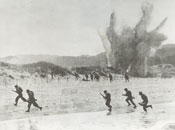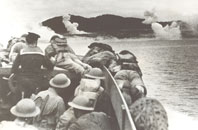Two years before the Allies launched their full-scale invasion of German-occuppied France, they tested themselves with a raid on the port city of Dieppe. They learned that they had a lot to learn.
By Brian John Murphy
By 1942 the Allies were discussing a possible invasion of German-occuppied France across the English Channel for as early as the spring of 1943. One obvious strategy on the table was to capture a port city first, to make it easier to supply the invading armies as the campaign continued inland. Such an operation would also serve as a dress rehearsal for a later full-scale amphibious invasion of France. Allied brass set their targets on Dieppe, France, near the Pas-de-Calais, where the English Channel was at its narrowest.
 US Army Rangers, still wearing the WWI-model helmet, rush ashore at Dieppe, France, on August 19, 1942. Though the Dieppe invasion force was mostly Canadian, nearly 70 US Rangers also participated. (National Archives)
US Army Rangers, still wearing the WWI-model helmet, rush ashore at Dieppe, France, on August 19, 1942. Though the Dieppe invasion force was mostly Canadian, nearly 70 US Rangers also participated. (National Archives)
Strategists decided the Dieppe attack would be a Canadian 2nd Division show. The division had been in England for two years, and the men were bored with army routine and eager for action. Now, elements of some of Canada’s finest regiments would finally get to fight. Also participating in the operation would be some British troops and marines and 68 US Army Rangers, who would become the first US forces to set foot on mainland Europe during the war. The plan, as developed by British Admiral Lord Louis Mountbatten, called for the seizure of the port and a 48-hour occupation.
British Royal Air Force fighters from bases in England—48 Spitfire squadrons, and the three British Eagle Squadrons with their American pilots—would cover the landings. There would be four main landing zones. From east to west, the beaches were named Blue, Red, White, and Green. Forces that landed on Blue and Green beaches would land on either side of Dieppe, and the Red and White beach landing forces would assault the city directly. Thirty brand-new Churchill tanks would get their baptism of fire in the raid. A task force of nearly 240 ships would deliver the troops and supply supporting gunfire.
Preparation for the invasion proved not to be thorough enough, especially air reconnaissance. RAF aircraft flew sorties over the landing areas and their approaches, but the airborne observers somehow failed to notice the underwater minefield and the many gun emplacements, pillboxes, and machine-gun nests. Nor did anyone discover that the Germans regularly patrolled the waters with the nimble torpedo boats known to the Allies as E-boats (and to the Germans as S-boats, from schnellboot). This last omission would impact on the amphibious invasion from the very outset of the assault.
The Allied invasion task force set out across the English Channel toward Dieppe on the morning of August 19, 1942. Early on, E-boats struck several ships and shed the first Allied blood of the raid. More E-boats attacked the task force as it neared the shore, sinking a Canadian landing craft.
The Canadians’ luck got worse: the Germans had decided to run a full-dress rehearsal of their own that very morning, an anti-invasion drill. All defensive posts were manned and ready when the Canadians loaded onto their landing crafts. Two German regiments awaited the invaders. The 571st Infantry defended Dieppe, the adjacent village of Puys, and a radar station at Pourville. West of the city, the 570th Infantry defended a battery at Berneval.
Two regiments of Canadians, the Royal Hamilton Light Infantry and Les Fusiliers Mont-Royal, landed at White Beach, attacking the city itself. To the east, on Red Beach, the Essex Scottish Regiment assaulted the city beach with 553 men.
 The Rangers had practiced intensively for the Dieppe invasion. Here, aboard a British landing craft, they approach a stretch of British coast under simulated artillery fire during a training exercise. (National Archives)
The Rangers had practiced intensively for the Dieppe invasion. Here, aboard a British landing craft, they approach a stretch of British coast under simulated artillery fire during a training exercise. (National Archives)
The Scots ran into a buzz saw. The Germans had cleared fields of fire by razing tourist hotels and establishing a multitude of machine-gun nests. In Dieppe’s old casino, pillboxes marred the ground floor, while snipers perched in the upper floors. Barbed wire on the beach was 6 to 10 feet thick. More trimmed the top of the seawall, and still more protected the esplanade beyond. Only 20 Allied soldiers ever got beyond the beach. The Scots suffered 91 percent casualties while pinned down on the sloping ground.
At White Beach, the Royal Hamilton Light Infantry reached the casino and cleared out the bottom two floors. Elements of the regiment forced their way into the town, but failed to capture their objective, the telephone exchange. Of the 582 Royal Hamiltons who assaulted Dieppe, 63 percent were killed, wounded, or captured.
The Royal Canadian Navy landed Les Fusiliers Mont-Royal west of White Beach. The 584-man regiment suffered 79 percent casualties.
The Calgary Tank Regiment of Churchill tanks arrived 10 minutes late and wasn’t there to cover the infantry landing. As a result, about 200 ground troops were lost. Two tanks of the Calgary Regiment went down in the water with their crews. Many of the rest bogged down in sand and shingle on the beach. But several tanks outflanked the seawall and engaged the German defenders from the esplanade. Forty-three percent of the 417 tank crewmen were casualties.
On Blue Beach, east of the city, the Royal Regiment of Canada, with elements of the British Black Watch Regiment, were shredded by machine-gun fire. Only a few men ever got off the steeply sloped beaches. By day’s end, half of the 554 men had died or were fatally wounded. Only 65 made the trip home, and only 22 of those were unwounded.
The South Saskatchewan Regiment and the Queen’s Own Cameron Highlanders of Canada assaulted Green Beach west of the city. The Highlanders landed with bagpipes playing and made the deepest penetration of all, two miles inland, but were stopped short of the German airfield that was their target. Forty-seven percent of their 503 men were casualties.
The South Saskatchewan Regiment landed west of its objective and had to cross a bridge under heavy fire to reach its objective. The courageous Lieutenant Colonel Cecil Merritt led the way. He would earn a Victoria Cross, the pinnacle of military honors in the British Commonwealth countries, for his effort. One survivor Meritt’s heroic leadership: “‘Now men,’ he said, ‘we’re going to get across. Follow me. Don’t bunch up together, spread out. Here we go!’ Erect and bareheaded, he strode forward onto the bridge. His helmet hung from his wrist as he walked. As I watched him lead his men through that thundering barrage, I felt a quiver run up and down my spine. I’d never seen anything like it.” Later in the day Merritt would lead a tough rearguard action covering the withdrawal from the beach. Of 523 South Saskatchewan infantrymen, 32 percent were killed, wounded, or captured.
In the end some 3,263 Canadians and their allies landed at Dieppe. The invasion force as a whole suffered 60 percent casualties. The Royal Canadian Air Force lost 119 planes and the Royal Canadian Navy 555 men killed. Of the Canadian casualties, 907 had been killed in action.
The fight taught the Allies valuable lessons about amphibious operations and ruled out any possibility of directly assaulting another port city. Canada remembers with pride and sorrow the raw courage and daring of her sons at Dieppe—and the heavy price they paid for the success of the D-Day landings at Normandy almost two years later.


FOLLOW US »
